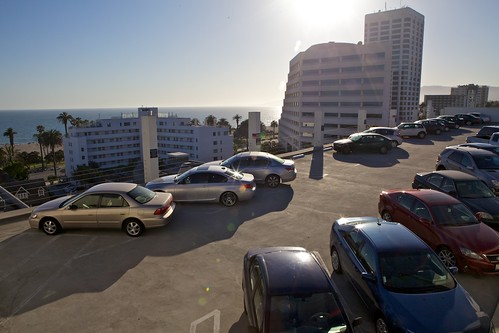This Wednesday, the Santa Monica Planning Commission deliberated on whether or not advise the City Council to push back the updates to the parking ordinance of the zoning code a full year, and after other land use zoning changes are completed. During testimony, I personally testified against delay and was glad that amongst the back and forth discussion and numerous public comments that included a lot of skepticism about parking policy changes (along with some support for change).
The final motion did not defer the timeline. Instead they called for a second draft update to be presented before the rest of the zoning code, along with options for forming a transportation management association.
The whole conversation was a bit much to cover and the Santa Monica Daily Press has some of it. My favorite string of comments for the night came from commissioner Jim Ries, who drew a connection from parking policy and auto-orientation to public health, the environment, and foreign entanglements...“Where our oil ends up on other people’s land.” I was glad someone on the commission made this about more than just driving convenience.
After planning and zoning decisions are made, communities have to live with the results for many years. Relaxing or reforming minimum parking zoning is more about how much parking will be built moving forward than what has already been done. Santa Monica is making policy choices (and leaving existing policy in place is choice), which are by their nature very future oriented. However the local conversation is based on present conditions or clinging to nostalgia for an era long since past.
Attempting to chart how best to respond to the conditions of the future is no simple task, both because the number of variables at work are vast, and because we both shape future conditions and adapt and respond to them. If everything operates in a predictable fashion, than rigid systems may work fine.
However, there is little reason to expect consistency in the next 20 or the next 40 years. Adaptability, resilience, or Nicholas Taleb’s concept of “anti-fragility”, however we call it is critically important. The inflexible systems of arbitrary mandates such as high parking minimum zoning, we have dating back to policy thinking several decades ago, is not what we need right now.

Choices which shape infrastructure building are not like other choices. We can hire or fire teachers, shift priorities for law enforcement spending, raise or lower taxes, essentially at will and if we want to go back to prior state rapidly we can make that choice. The built environment is different, these are choices that will leave buildings or public works for many decades, and there is a physical cost of resources associated with changes. Building just for the whims of the present is not good policy for those of us with a lot of potential existence left, or to the generations that follow.
When imagine the plausible futures for transportation heading toward and beyond the mid-21st century, there are six pivotal overlapping and interacting factors that loom largest to me, and almost assuredly demand significant changes to the status quo on their own, but especially considered in tandem. They are climate change, unsustainable depletion of resources, cultural value shifts, economic shifts, disruptive technologies and to bring up Taleb again, unpredictable, unknown, but potentially game changing, black swan events.
Parking policy plays a part in shaping and responding to all six of these factors, whether we tend to acknowledge that or not. When it comes to the big issues of global impact or national security, as a society we tend to fixate on national policy. However lurking around the legacy municipal zoning codes of cities and towns across America are mandates with significant implications for many our biggest challenges, and which can be more attainably confronted by most citizens than the difficult task of swaying a gridlocked and deeply unpopular congress.








